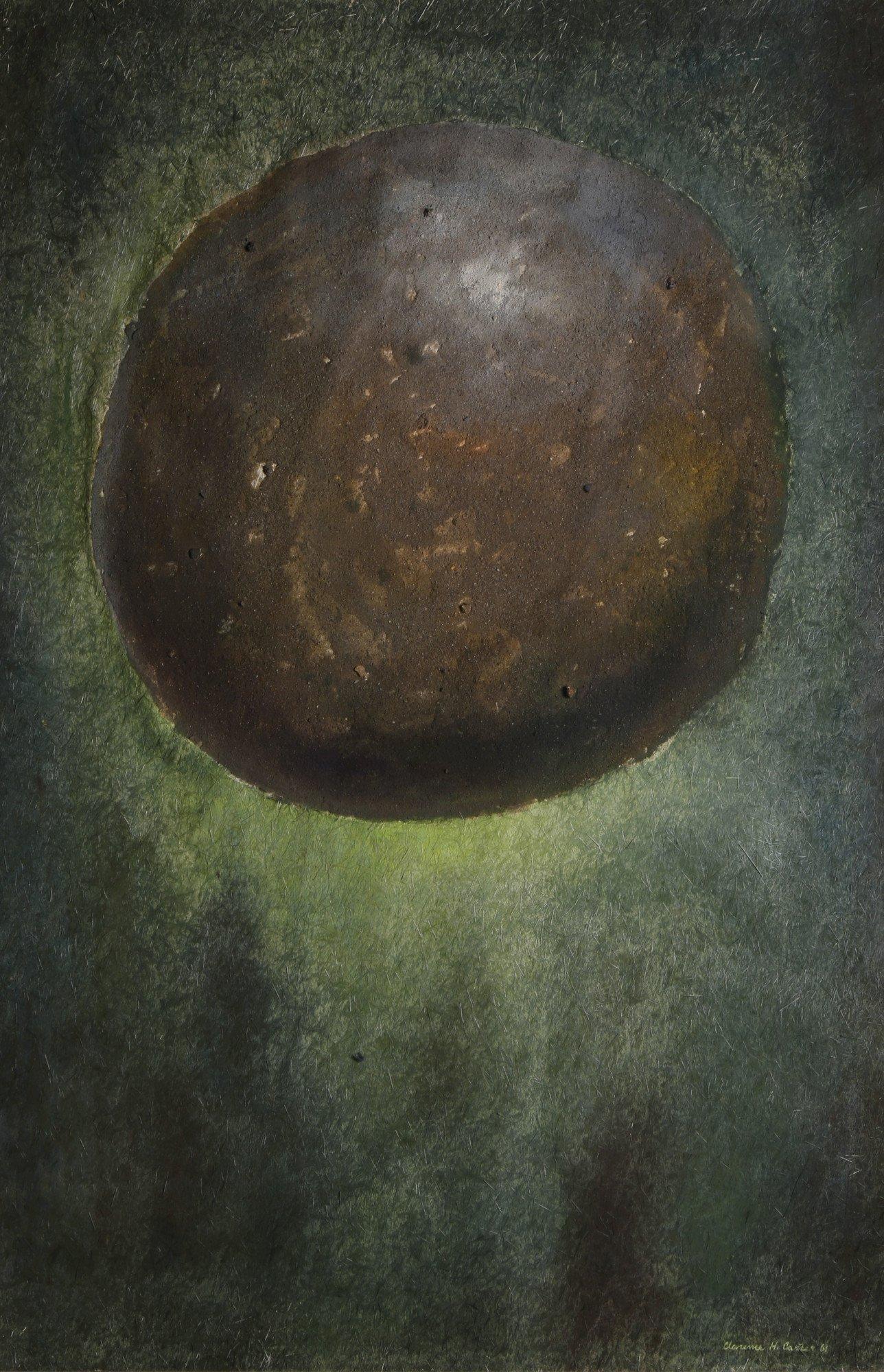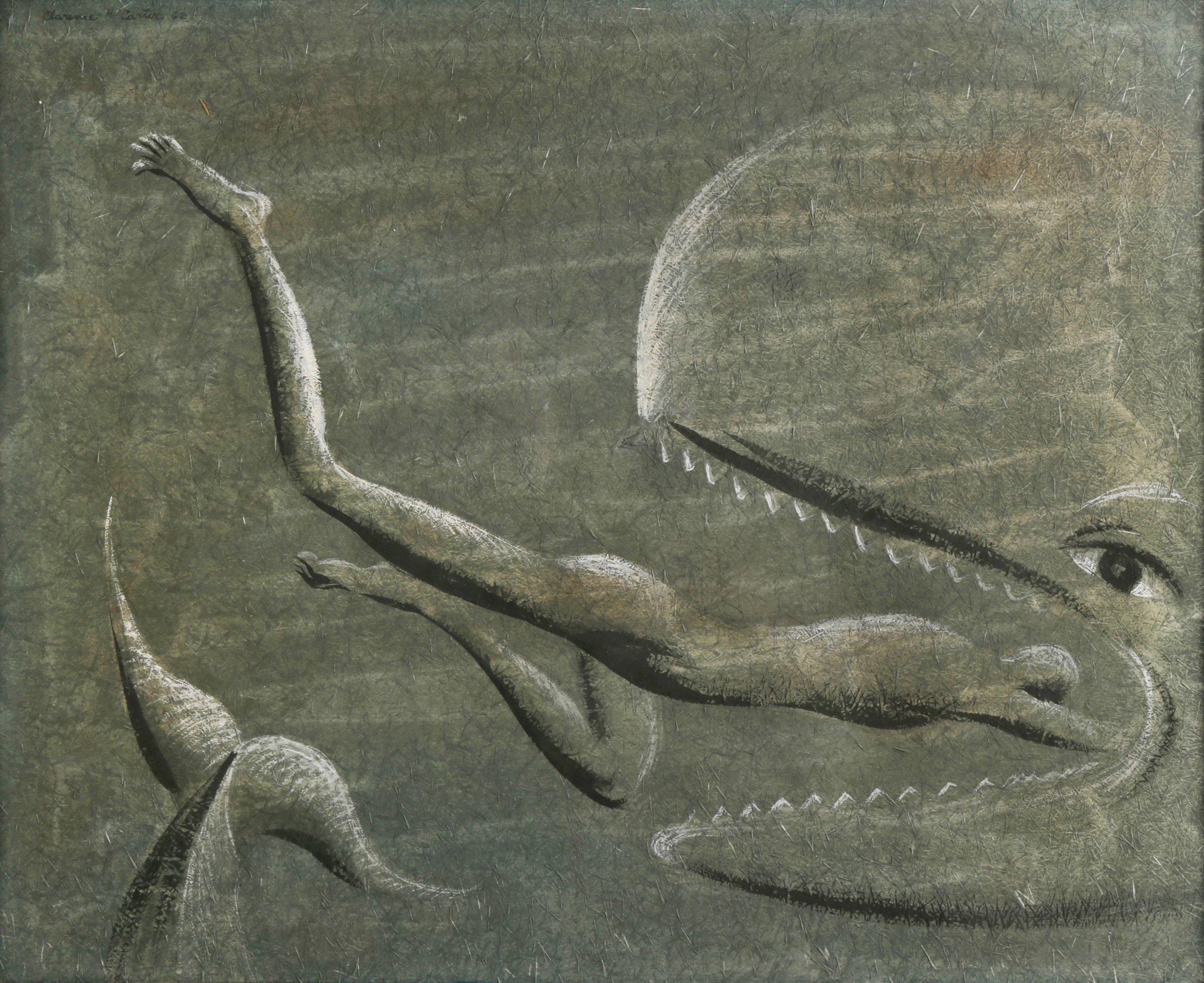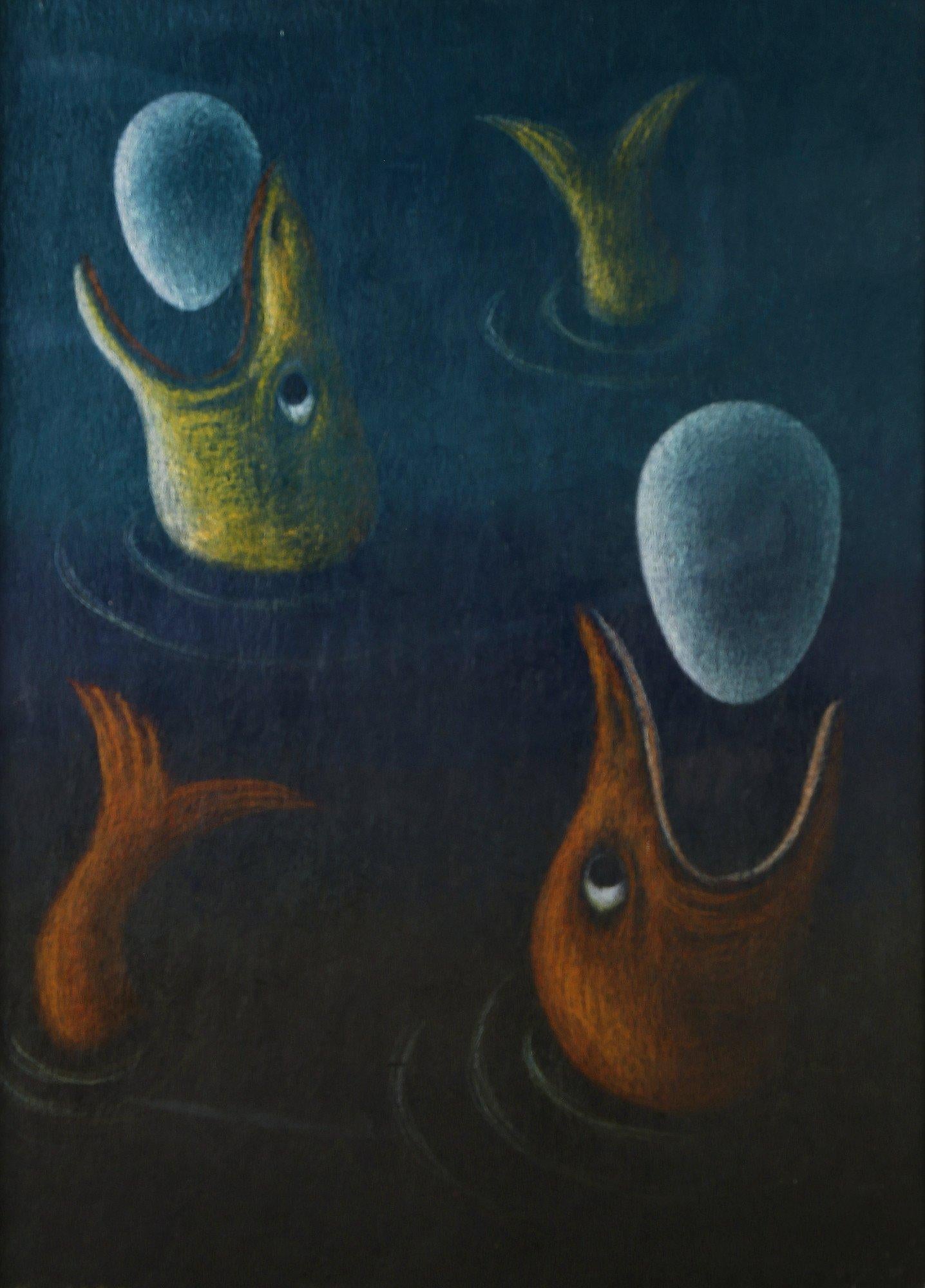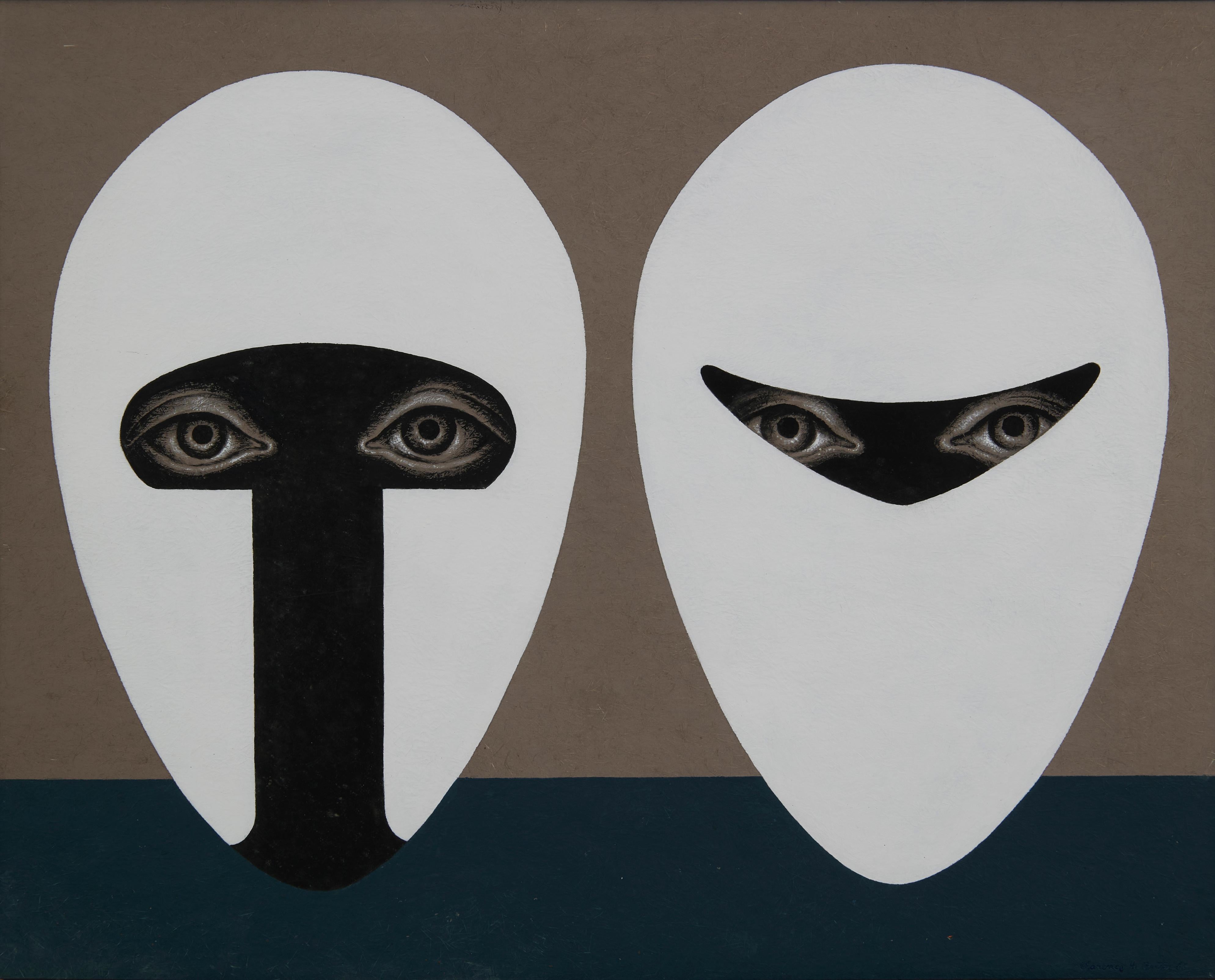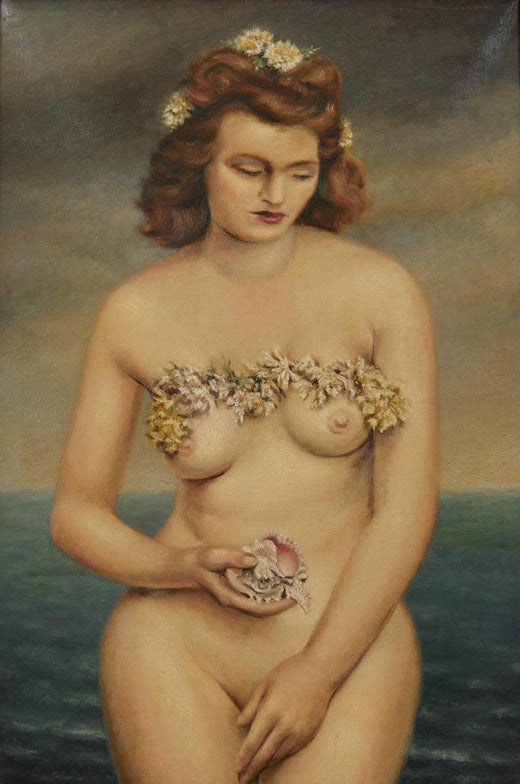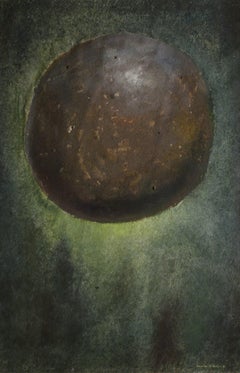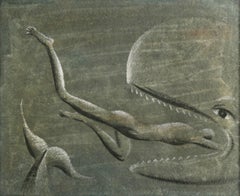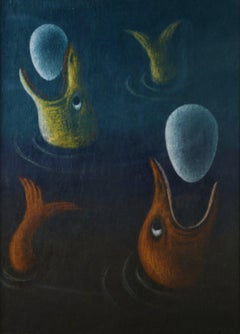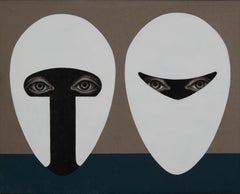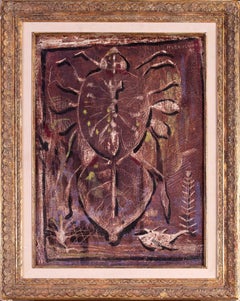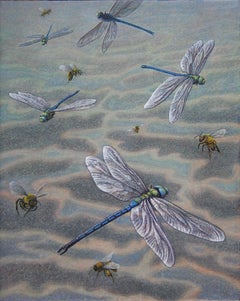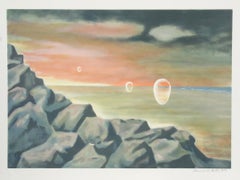Items Similar to Cicada, Mid-century Figural Surrealist Cleveland School Painting, 1960s
Want more images or videos?
Request additional images or videos from the seller
1 of 8
Clarence Holbrook CarterCicada, Mid-century Figural Surrealist Cleveland School Painting, 1960sc. 1960s
c. 1960s
$8,500
£6,449.60
€7,374.55
CA$11,872.20
A$13,200.27
CHF 6,892.45
MX$160,679.38
NOK 87,944.67
SEK 82,399.95
DKK 55,037.59
Shipping
Retrieving quote...The 1stDibs Promise:
Authenticity Guarantee,
Money-Back Guarantee,
24-Hour Cancellation
About the Item
Clarence Holbrook Carter (American, 1904-2000)
Medieval Heads, 1966
Acrylic on scintilla
Signed and dated upper right
23.5 x 30 inches
Clarence Holbrook Carter achieved a level of national artistic success that was nearly unprecedented among Cleveland School artists of his day, with representation by major New York dealers, scores of awards and solo exhibits, and streams of praise flowing from pens of the top art critics. Over the course of his 60+ year career Carter evolved from an exceptionally fine American Scene painter capable of evoking deep reservoirs of mood, into an abstractionist with a strongly surrealist bent.
While his two bodies of work seem at first to be worlds apart, owing to their different formal vocabularies, they, in fact, explore virtually the same subject: the nexus between life and death and the transition from earth to spirit. The early work finds its expressive power through specific people, events, and landscapes—most of which are drawn from his experiences growing up in the river town of Portsmouth, Ohio—while the later work from the 1960s on evokes potent states of being through pure flat shape, color and form that read as universals. As his primary form he adopted the ovoid or egg shape, endowing it with varying degrees of transparency. Alone or in multiples, the egg moves through Carter’s landscapes and architectural settings like a sentient spirit on a restless quest.
Born and raised in southern Ohio along the banks of the mercurial Ohio River and its treacherous floods, Carter developed a love of drawing as a child, and was encouraged by both his parents. He was self-directed, found inspiration all around him, and was strongly encouraged by the fact that his teenage work consistently captured art prizes in county and state fairs. Although money was tight after his father (who was a postal worker) died suddenly of a stroke, Carter’s mother supported his desire to study at the Cleveland School of Art from 1923-27, where he trained under painters Henry Keller, Frank Wilcox and Paul Travis.
In the summer of 1927, Carter studied in Capri with the modernist Hans Hofmann, where he carried out compositional exercises in charcoal and paint, recording the lucid spatial order of stairs, walls, roofs, arches and other elements of the island’s compressed architecture. Returning to Cleveland in 1929, Carter had his first solo show, and through Milliken taught studio classes at the Cleveland Museum of Art from 1930-37. In 1934, he worked under the auspices of the Public Works of Art Project and won a commission to paint two murals in Cleveland’s Public Auditorium. In 1936, he painted a post office mural in Ravenna, Ohio, as well as one for the post office in his hometown of Portsmouth, where his father had worked. He then headed the Northeast Ohio division of the painting projects arm of the Works Progress Administration, a subsequent government art program. In 1938, he moved to Pittsburgh to teach at the Carnegie Institute of Technology until 1944. Carter’s American Scene paintings of the ’30s and ’40s, which launched his artistic star, are the works for which the artist remains best known.
During and immediately after World War II, Clarence Carter realized his attraction to bold pattern, dramatic perspective and eye-catching hard-edged design was a poor fit with the prevailing style of Abstract Expressionism. Fortunately, these same hallmarks of his style were prized within the realm of commercial art. Thus, from 1944-1959, Carter became a veritable “Mad Man [Madison Avenue Man],” designing ambitious series of advertisements for major corporations such as Alcoa and The National City Bank of New York (Citibank) which appeared on the back covers of Fortune magazine, and on inside pages of Time, Newsweek, Business Week, and US News & World Report. Carter described this period of his life as one of incredible inventiveness and imagination. It freed him up to be far more experimental in his approach to image-making.
Around 1964 Carter acknowledged a need to break from the confines of representational painting. Once Carter had found a potent symbol in the egg, he used it to create an astounding body of imagery for the rest of his life. Among the most ambitious of all his later paintings were his Transections, a theological term meaning to cross, specifically between life and death.
- Creator:Clarence Holbrook Carter (1904-2000, American)
- Creation Year:c. 1960s
- Dimensions:Height: 30 in (76.2 cm)Width: 20 in (50.8 cm)
- Medium:
- Movement & Style:
- Period:
- Condition:
- Gallery Location:Beachwood, OH
- Reference Number:1stDibs: LU1768212972282
Clarence Holbrook Carter
Clarence Holbrook Carter achieved a level of national artistic success that was nearly unprecedented among Cleveland School artists of his day, with representation by major New York dealers, scores of awards and solo exhibits, and streams of praise flowing from pens of the top art critics. Over the course of his 60+ year career Carter evolved from an exceptionally fine American Scene painter capable of evoking deep reservoirs of mood, into an abstractionist with a strongly surrealist bent. While his two bodies of work seem at first to be worlds apart, owing to their different formal vocabularies, they, in fact, explore virtually the same subject: the nexus between life and death and the transition from earth to spirit. The early work finds its expressive power through specific people, events, and landscapes—most of which are drawn from his experiences growing up in the river town of Portsmouth, Ohio—while the later work from the 1960s on evokes potent states of being through pure flat shape, color and form that read as universals. As his primary form he adopted the ovoid or egg shape, endowing it with varying degrees of transparency. Alone or in multiples, the egg moves through Carter’s landscapes and architectural settings like a sentient spirit on a restless quest. Born and raised in southern Ohio along the banks of the mercurial Ohio River and its treacherous floods, Carter developed a love of drawing as a child, and was encouraged by both his parents. He was self-directed, found inspiration all around him, and was strongly encouraged by the fact that his teenage work consistently captured art prizes in county and state fairs. Carter studied at the Cleveland School of Art from 1923-27, where he trained under painters Henry Keller, Frank Wilcox and Paul Travis. Returning to Cleveland in 1929, Carter had his first solo show, and through Milliken taught studio classes at the Cleveland Museum of Art from 1930-37. In 1938, he moved to Pittsburgh to teach at the Carnegie Institute of Technology until 1944. Carter’s American Scene paintings of the ’30s and ’40s, which launched his artistic star, are the works for which the artist remains best known. During and immediately after World War II, Clarence Carter realized his attraction to bold pattern, dramatic perspective and eye-catching hard-edged design was a poor fit with the prevailing style of Abstract Expressionism. Fortunately, these same hallmarks of his style were prized within the realm of commercial art. Around 1964 Carter acknowledged a need to break from the confines of representational painting. Once Carter had found a potent symbol in the egg, he used it to create an astounding body of imagery for the rest of his life. Among the most ambitious of all his later paintings were his Transections, a theological term meaning to cross, specifically between life and death.
About the Seller
5.0
Vetted Professional Seller
Every seller passes strict standards for authenticity and reliability
Established in 1975
1stDibs seller since 2022
34 sales on 1stDibs
Typical response time: 1 hour
- ShippingRetrieving quote...Shipping from: Beachwood, OH
- Return Policy
Authenticity Guarantee
In the unlikely event there’s an issue with an item’s authenticity, contact us within 1 year for a full refund. DetailsMoney-Back Guarantee
If your item is not as described, is damaged in transit, or does not arrive, contact us within 7 days for a full refund. Details24-Hour Cancellation
You have a 24-hour grace period in which to reconsider your purchase, with no questions asked.Vetted Professional Sellers
Our world-class sellers must adhere to strict standards for service and quality, maintaining the integrity of our listings.Price-Match Guarantee
If you find that a seller listed the same item for a lower price elsewhere, we’ll match it.Trusted Global Delivery
Our best-in-class carrier network provides specialized shipping options worldwide, including custom delivery.More From This Seller
View AllDeparting from the System, Mid-Century Geometrical Abstract Mixed Media
By Clarence Holbrook Carter
Located in Beachwood, OH
Clarence Holbrook Carter (American, 1904-2000)
Departing from the System, 1961
Mixed media on paper
Signed and dated lower right
36 x 24 inches
A surrealist mid-century figural abst...
Category
1960s American Modern Abstract Paintings
Materials
Mixed Media
Dichotomy, mid-century figural abstract green oil painting
By Clarence Holbrook Carter
Located in Beachwood, OH
Clarence Holbrook Carter (American, 1904-2000)
Dichotomy, 1962
Oil on paper
Signed and dated upper left
20 x 25 inches
Mid-century figural abstract green painting of woman swimming ...
Category
1960s American Modern Abstract Paintings
Materials
Oil
Chimeras, mid-century figural abstract blue acrylic painting
By Clarence Holbrook Carter
Located in Beachwood, OH
Chimeras, 1974
Acrylic and pastel on textured paper
Mid-century figural abstract blue acrylic painting
Clarence Holbrook Carter achieved a level of national artistic success that w...
Category
1970s American Modern Figurative Paintings
Materials
Pastel, Acrylic
Medieval Heads, mid-century figural surrealist acrylic painting
By Clarence Holbrook Carter
Located in Beachwood, OH
Clarence Holbrook Carter (American, 1904-2000)
Cicada, c. 1960s
Watercolor on scintilla
30 x 20 inches
Clarence Holbrook Carter achieved a level of national artistic success that wa...
Category
1960s American Modern Figurative Paintings
Materials
Acrylic
Ovoid, geometrical figural surrealist acrylic painting, Cleveland School artist
By Clarence Holbrook Carter
Located in Beachwood, OH
Clarence Holbrook Carter (American, 1904-2000)
Ovoid, 1992
Acrylic on canvas
Signed and dated lower right
7.75 x 7.75 inches
9 x 9 inches, framed
Clarence Holbrook Carter achieved a...
Category
1990s American Modern Abstract Paintings
Materials
Acrylic
Air Chamber, Mid-Century Figural Abstract Collage, Anatomy & Ovoids
By Clarence Holbrook Carter
Located in Beachwood, OH
Clarence Holbrook Carter (American, 1904-2000)
Air Chamber, 1965
Collage, graphite and gouache on paper
Signed and dated upper left
30 x 22 inches
Provenance: Descended through the family.
Clarence Holbrook Carter achieved a level of national artistic success that was nearly unprecedented among Cleveland School artists of his day, with representation by major New York dealers...
Category
1960s American Modern Abstract Paintings
Materials
Gouache, Graphite
You May Also Like
Mid 20th Century oil painting of a cicada by Belgian artist Baugniet
Located in Petworth, West Sussex
Marcel Louis Baugniet (Belgian, 1896 – 1995)
Sigale de Mer (Cicada of the sea)
Oil on board with scraffito
Signed ‘M L BAUGNIET / 47’ (upper right)
17.3/4 x 13.1/2 in. (45 x 34.3 cm.)
Marcel-Louis Baugniet was born in Liege on the 18th March 1896. Painter, theorist, furniture designer, creator of posters, costumes and stage sets, he was one of the main defenders of the notion of Pure Plastic Arts.
Baugniet studied painting at the Royal Academy of Beaux-Arts in Brussels where he mixed with Paul Delvaux, René Magritte, Victor Servrancks and Pierre-Louis Flouquet. He spent some time in Paris and decided that he would become an iconoclastic and avant garde artist. He discovered abstract art with Kandinsky, Kupka, Mondrian and Delaunay and with wonder and stupeur he also learnt of the constructivist movement, which was born in Russia with Malevitch and Lissitsky. In 1922, Baugniet then 26 years old returned to Brussels and married the Russian danser Akarova for whom he designed costumes and stage sets.
M-L Baugniet painted, designed and engraved some superb series of dansers and sportspersons (the « Kaloprosopies »), works entrenched with impeccable lines of constructed art. He painted with contemplation geometric compositions which mixed a grace of colours with the rigour of shapes. Baugniet wrote articles on esthetics and applicated arts in the magasine 7 Arts and edited, with the Dutch architect Van Tonderen, the manifesto of the movement that they called « Le beau, C’est l'utile » (beauty is useful)
Towards the end of the 20s, he separated from Akarova and in 1927 he opened his own Home Decor shop.
With regret Baugniet laid down his paint brushes and threw himself into interior design and the creation of tubular furniture, everyday objects and carpets. He remarried the Russian Olga Reich. He created a circle of ideas that included artists, writers, politicians and intellectuals of all kinds.
Throughout his career, Baugniet participated in numerous international exhibitions of decorative art. In 1977 abstraction, constructivism and Marcel-Louis Baugniet were rediscovered. Decorated and lauded, Baugniet began to paint once more and co-founded the magasine Mesures with Jo Delahaut...
Category
Mid-20th Century Expressionist Animal Paintings
Materials
Oil, Board
Hovering, surrealist egg tempera insect and skyscape painting
By Douglas Safranek
Located in New York, NY
Douglas Safranek's Hovering captures the tension of liminal space. Bees and dragonflies appear pinned, and specimen-like, yet achieve loftiness with their wings. Their hyperbolized d...
Category
2010s Surrealist Animal Paintings
Materials
Egg Tempera, Illustration Board
Eschatos #21, Surrealist Landscape Screenprint by Clarence Holbrook Carter
By Clarence Holbrook Carter
Located in Long Island City, NY
Artist: Clarence Holbrook Carter, American (1904 - 2000)
Title: Eschatos 21
Medium: Screenprint, signed and numbered in pencil
Edition: 200, 30 AP
Size: 23 in. x 29 in. (58.42 cm x 7...
Category
1970s Surrealist Landscape Prints
Materials
Screen
Cicada, 2020. Oil on canvas, 30 x 24 cm
Located in Riga, LV
Works of Liene Liepina are full of life and joy because of photography-like, realistic details on the one hand, and intense and slightly artificial color...
Category
2010s Contemporary Still-life Paintings
Materials
Canvas, Oil
$911 Sale Price
20% Off
Queen moth -Timothy Archer, 21st Century, Contemporary painting
By Timothy Archer
Located in Paris, FR
Oil paint and pastel on paper
Signed and dated by the artist
Category
2010s Contemporary Figurative Paintings
Materials
Paper, Oil Pastel, Oil
Korean Contemporary Art by Kim Soo Young - Face of Women with Insects
Located in Paris, IDF
Hand drawing with pencils, posca and acrylic on paper,
Optional frame upon simple request.
Kim Soo Young is a Korean artist born in 1978 who lives and works in Seoul, South Korea. T...
Category
2010s Contemporary Figurative Paintings
Materials
Acrylic, Pencil, Paper
More Ways To Browse
Mid Century Modern Painting Figure
Cleveland School
Star Wars Painting
Vintage Fortune Magazines
C Hans Paintings
1960s Hard Edge Painting
Medieval Head
Madison Avenue Art
Mid Century Hard Edge Painting
Capri Painting
Paintings Of Capri
Mad Magazine
Vintage Cross Pens
Clarence Wells
Mad Charcoal
Cicada Painting
Wildlife Oil Paintings
Bird Art Framed Set
